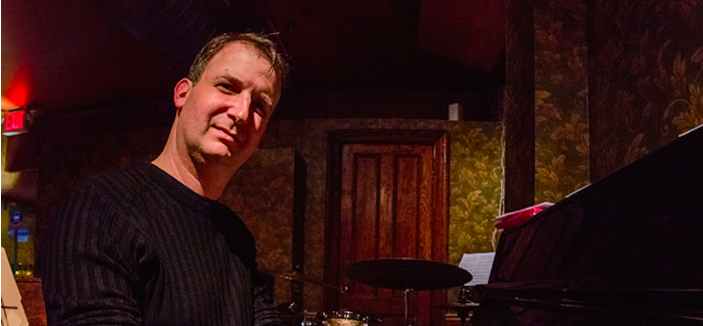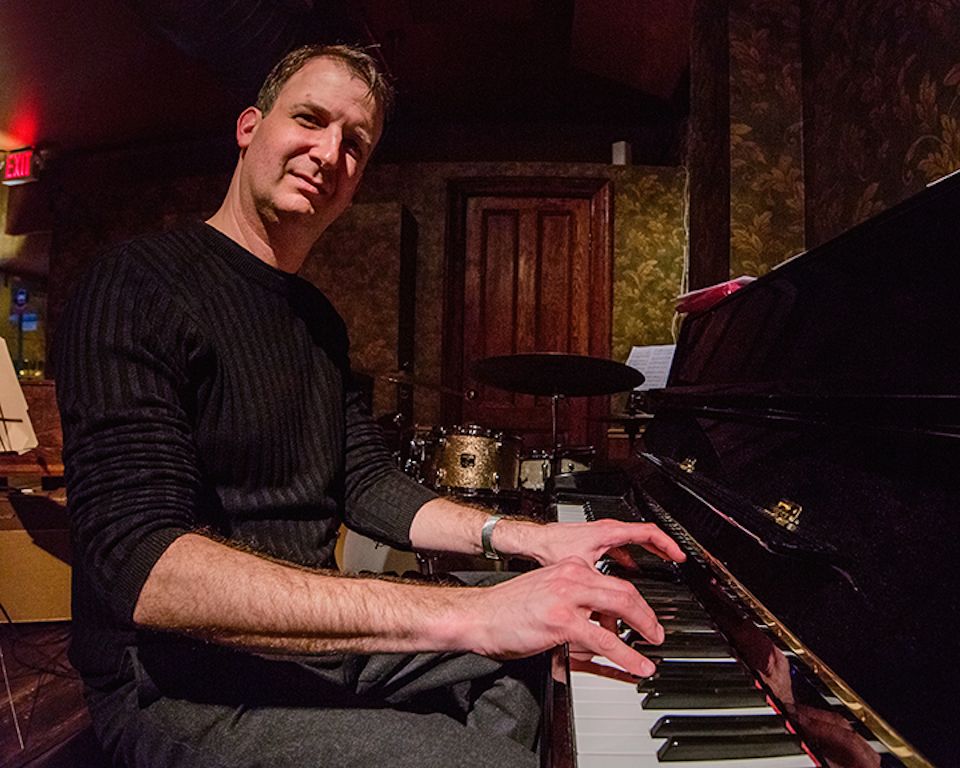A “Museum Of Keyboards”: Exploring Bennett Paster’s Kensington Music Studio


You might think that for a small recording studio located in the basement of a house in Kensington, the presence of a Steinway grand piano would be the most extraordinary factor in the business’ success. But for Benny’s Wash N Dry, it’s also those three things crucial to so much New York commerce: location, location, location.
“We’re basically between the Cortelyou Road business district and the Kensington/Church Avenue and the Fort Hamilton business districts, about the same walk to all those places,” explained the owner, Bennett Paster. “What I’ve seen in the 15 years I’ve been here is that musicians moved in around me and all the way kind of down the Q train line toward Cortelyou, Ditmas, and Newkirk.”
Paster, a keyboardist himself, says the studio comprises a “well-curated collection of essential classic keyboards.” In addition to the Steinway, the Wash N-Dry studio offers access to instruments that have shaped a century of popular music. The collection includes a Fender Rhodes electric piano, a Hammond CV organ with a Leslie speaker, and much more.
On a recent Monday afternoon, Paster finished helping a client record backing tapes for a theatrical performance celebrating Edith Piaf and sat down for a wide-ranging conversation about living and working in Kensington, the stories behind some of the most famous names in the music business, and the experience of running a recording studio.
How long has the studio been here?
I’ve had the house for 15 years and I opened the studio right away when I got here. It took a while to get to the functional professional level that it’s at now.
When we renovated the house seven and a half years ago is when we put in the proper vocal-booth, that completely floated, isolated room. So, 15 years, but the last seven or eight years, the work has gotten really good.
Did you have all the keyboards when you moved in?
Not all of them, but I moved from Boston with this 1933 Steinway B (6’10”) piano — I got it in ‘93 or ‘94. I had the Wurlitzer (electric piano), and the mini-Moog Model D and the clavinet. The Hammond I got here in New York from my keyboard tech. So actually, I had most of them when I moved.
When I first got all these instruments, none of my contemporaries had the real things, we all used samples. Twenty-five years ago when I started buying them, everybody knew what they sounded like from the records but everybody wanted the new keyboards. I chose the old ones because the experience of playing them is that of playing a vital, breathing instrument, not triggering a recording of an instrument.
Where does the name Benny’s Wash N Dry come from?
Exactly where we’re sitting, right here, there used to be a washer and dryer. The goal was for the name to be casual and to kind of make people feel comfortable in the studio, not to feel like they were going to some big expensive place where they had to be nervous and it was formal.
What effect do you think being in Kensington has on the business and the people who come here?
There are so many musicians in Brooklyn. The reason I moved to Brooklyn in ‘96, Windsor Terrace at the time, was because all my jazz-musician friends from Boston were living in Park Slope. I didn’t realize at the time what a big decision what neighborhood you pick to move to in New York City has on your whole life.
You just think you are getting an apartment and that’s that, but the people you surround yourself with, and are convenient to play with, become the people you do projects with. A jam session leads to a project.
It’s really hard for a drummer to drive over here from Queens in the middle of the day to play. Not that they can’t do it, but it’s a hassle. So you’re going to call someone who lives close. With so many musicians living close, it was a good place to live.
I moved to Kensington because I couldn’t afford a house in the Terrace. (Now I couldn’t afford this house, if I had to buy it again.)
Some people claim that Steinway became the most famous piano manufacturer in the world because they bribed the judges at 1he 1876 Centennial Exposition in Philadelphia. Have you heard that story?
I never have!
Do you think that Steinway is prominent because the company has the best workmanship, the best PR, or a combination of both?
It never occurred to me that it wasn’t somehow rooted in the actual quality of the instruments because I’ve always found Steinways in general to be a very fine make of piano. But they are not the only fine make of piano. There are tons of great European pianos, and Japanese and Korean pianos made now, but I think that Steinway has long been synonymous with quality and they certainly built a recognizable brand name around their quality.
If a trained pianist hears a Steinway, can they recognize it from other brands, and what is the tell?
Different piano brands, and makes, definitely have sound flavors associated with them.
But could you identify a Steinway upon hearing? I think most people could not, but perhaps some savvy piano aficionados could. You can generally tell if a piano is not a Steinway. There’s a lot of bad, really bright, pianos out there.
The sound of the Fender Rhodes is quite distinctive, because along with the Wurlitzer, it was one of the first electric pianos. How would you compare those with the Steinway?
Oh, it couldn’t be more different. The piano is a super complex waveform full of different harmonics. It’s rich with different harmonics. And especially the Fender Rhodes is a very pure sound with very few overtones and harmonics. It’s bell-y, almost crystal clear.
[Listen to Paster play the Fender Rhodes with Trio Brasileiro on the track Kingfisher.]
Harold Rhodes was an inventor, not a piano manufacturer. A Fender Rhodes has a rubber hammer-tip at the end of a very simple lever, hitting a metal tine.
If you were to choose a recording that has that iconic Fender Rhodes sound, what would you think of?
Pink Floyd: “Money.” Stevie Wonder, um–dun-dun-dada dun dun — “I Wish.”
Now that there are polyphonic keyboard synthesizers that can produce virtually any sound, what is a musician looking for when they come to the studio to play a Fender Rhodes?
The synthesizers, samplers and workstation keyboards have gotten great, but what they lack is the fact that every time you play the same note on a piano or Rhodes, it’s going to be a little bit different. Physics just dictates that it vibrates a little differently. And the way those notes all sympathetically affect each other while they are vibrating gives the instrument a certain richness that a sample or even a very, very complex computer model can’t quite get to.
The Leslie is a kind of speaker that’s been used with many different instruments, but the classic combination is a Leslie speaker paired with a Hammond organ, which is what you have here. But I’ve heard that Donald Leslie, who invented it, hated Hammonds. How did they end up so closely associated?
I should know the story better, but it goes something like this: The organ in a church setting, a pipe organ (which is originally what the Hammond was intended to replace), has pipes that would be spread throughout that church. So when you play it, it literally sounds like it is coming from everywhere. Nothing’s moving, but the sound is coming from all over the room.
Don Leslie wanted the electric organ to sound like it was coming from all over the room. And his innovation was, if you can’t make the organ spread out around the room, make the speaker rotate to simulate the sound coming from around the room.
So on a Leslie, the top speaker spins, and the bottom speaker fires down and has essentially what is like a wooden bucket with a hole cut in one side that rotates opposite from the top. And the sound fires out — the sound is projected through where the hole in the bucket is.
Leslie was trying to make the organ sound like it’s coming from all around the church. But what he didn’t factor in was that there was going to be this pitch and amplitude modulation. I don’t think that was part of his design aesthetic. But the result is just so cool!
And I don’t think Don Leslie achieved what he was going for but he accidentally invented the most incredible thing ever without which so much modern rock and pop and jazz and gospel would not sound the same.
[Listen to Paster play the Hammond Leslie with Organic! on “The Squirrel Next Door.”]
What records would you pick to give a sense of the classic Hammond Leslie sound?
Any Jimmy Smith record would give the classic jazz organ sound with a Leslie (“Back at the Chicken Shack”).
So Benny’s Wash N Dry could really be a museum of keyboards, except you’re committed to using them and putting them in service of people looking for something a little special in a recording studio.
My clients come from all over the city, and all over the tri state area, and in some cases even from overseas, but I definitely also try to serve the community. I do high school audition tapes and videos for people.
You have a great collection of instruments, and it seems like in some ways the studio itself is an instrument.
To me, that’s all part of the music making process. It’s hard for me to imagine making music without a studio now. As fun as it is to just go play piano on a gig — I love that — the process of making music in a contemporary setting is all about being able to use the old and the new together and to bring people together to make something new and interesting and to help artists realize their vision, both my clients’ and my own.
Paster will be performing on his meticulously renovated Fender Rhodes on Sunday, June 5, along with Jim Whitney on bass and Joe Strasser on drums at 61 Local (61 Bergen Street in Carroll Gardens).




